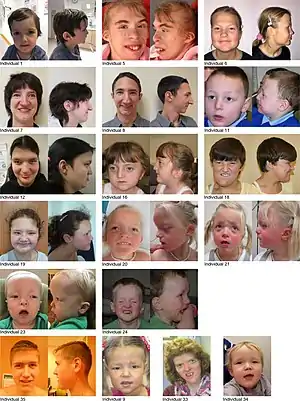Snijders Blok–Campeau syndrome
Snijders Blok–Campeau syndrome is a genetic disorder caused by mutations in the CHD3 gene.[1] It is characterized by impaired intellectual development, macrocephaly, dysarthria and apraxia of speech, and certain distinctive facial features.[2]
| Snijders Blok–Campeau syndrome | |
|---|---|
| Other names | SNIBCPS, IDDMSF |
 | |
| An image displaying 18 individuals who have Snijders Blok-Campeau syndrome | |
| Symptoms | Intellectual disability, Macrocephaly, distinctive facial features |
| Usual onset | Before birth |
| Duration | Life long |
| Causes | Mutations in the CHD3 gene |
| Frequency | Approximately 60 cases described in scientific literature, with an estimated 150 diagnosed worldwide |
Snijders Blok–Campeau syndrome is typically a de novo mutation[3][4] which generally occurs during the early embryonic stages of development or during the formation of the parent's reproductive cells.[2] This allows for prenatal diagnosis.[5]
Signs and symptoms
Snijders Blok–Campeau syndrome almost always comes with both physical and intellectual disabilities. Those with the condition will typically have trouble in the development of speech and language. Around one half typically have some form of macrocephaly, while around one third show signs of autism or similar conditions.[4]
| Characteristics | Percentage | Characteristics | Percentage |
|---|---|---|---|
| Developmental disorder | 100%[3][6] | Flexible ligamets | 40%[3] |
| Speech delay or disorder | 100%[3][6] | Central nervous system abnormalities | 39%[6] |
| Intellectual disability | 95%[6] | Male genital abnormalities | 35%[3] |
| Low muscle tone | 92%[6] | Autism or autism-like features | 33%[6] |
| Large or prominent forehead | 85%[3] | Neonatal feeding problems | 31%[3] |
| Widely spaced eyes | 77%[3] | Strabism | 30%[3] |
| Visual abnormalities | 75%[6] | Seizures | 21%[6] |
| Thin upper lip | 74%[6] | Congenital heart disease | 21%[6] |
| Broad nasal bridge | 71%[6] | Missing teeth | 16%[6] |
| Macrocephaly | 58%[3] | Hearing loss | 13%[6] |
| Deep set eyes | 54%[6] | Microcephaly | 5%[6] |
Cause
The CHD3 gene is required for chromatin remodeling, a process that regulates gene expression.[7] By allowing for the creation of chromatin, the CHD3 gene affects how tightly DNA is packed into chromosomes. A mutation of the CHD3 gene changes the amount of chromatin produced, causing over or underexpression of other genes.[7][8]
History
Due to the rarity of the condition, with only approximately 60 cases documented in scientific literature,[7] Snijders Blok–Campeau syndrome was only discovered in 2018 by clinical geneticist Lot Snijders Blok and clinician-scientist Philippe M Campeau. The mutation was first documented in the paper "CHD3 helicase domain mutations cause a neurodevelopmental syndrome with macrocephaly and impaired speech and language".[3]
References
- Fan, Xi-Yong (Sep 15, 2021). "Snijders Blok-Campeau syndrome caused by CHD3 gene mutation: a case report". Zhongguo Dang Dai Er Ke Za Zhi = Chinese Journal of Contemporary Pediatrics. 23 (9): 965–968. doi:10.7499/j.issn.1008-8830.2106091. ISSN 1008-8830. PMC 8480161. PMID 34535214.
- "Snijders Blok-Campeau syndrome (Concept Id: C4748701) - MedGen - NCBI". www.ncbi.nlm.nih.gov. Retrieved 2022-07-20.
- Snijders Blok, Lot; Rousseau, Justine; Twist, Joanna; Ehresmann, Sophie; Takaku, Motoki; Venselaar, Hanka; Rodan, Lance H.; Nowak, Catherine B.; Douglas, Jessica; Swoboda, Kathryn J.; Steeves, Marcie A. (2018-11-05). "CHD3 helicase domain mutations cause a neurodevelopmental syndrome with macrocephaly and impaired speech and language". Nature Communications. 9 (1): 4619. Bibcode:2018NatCo...9.4619S. doi:10.1038/s41467-018-06014-6. ISSN 2041-1723. PMC 6218476. PMID 30397230.
- Hoffmann, Anke; Spengler, Dietmar (Jul 24, 2019). "Chromatin Remodeling Complex NuRD in Neurodevelopment and Neurodevelopmental Disorders". Front Genet. 10: 682. doi:10.3389/fgene.2019.00682. PMC 6667665. PMID 31396263.
- Malinger, Gustavo; Hoffmann, Chen; Achiron, Reuven; Berkenstadt, Michal (2021). "Prenatal Diagnosis of Snijders Blok-Campeau Syndrome in a Fetus with Macrocephaly". Fetal Diagnosis and Therapy. 48 (5): 407–410. doi:10.1159/000514326. ISSN 1421-9964. PMID 34000720. S2CID 234768265.
- Drivas, Theodore G.; Li, Dong; Nair, Divya; Alaimo, Joseph T.; Alders, Mariëlle; Altmüller, Janine; Barakat, Tahsin Stefan; Bebin, E. Martina; Bertsch, Nicole L.; Blackburn, Patrick R.; Blesson, Alyssa (October 2020). "A second cohort of CHD3 patients expands the molecular mechanisms known to cause Snijders Blok-Campeau syndrome". European Journal of Human Genetics. 28 (10): 1422–1431. doi:10.1038/s41431-020-0654-4. ISSN 1476-5438. PMC 7608102. PMID 32483341.
- "Snijders Blok-Campeau syndrome: MedlinePlus Genetics". medlineplus.gov. Retrieved 2022-07-20.
- Hoffmann, Anke; Spengler, Dietmar (2019). "Chromatin Remodeling Complex NuRD in Neurodevelopment and Neurodevelopmental Disorders". Frontiers in Genetics. 10: 682. doi:10.3389/fgene.2019.00682. ISSN 1664-8021. PMC 6667665. PMID 31396263.